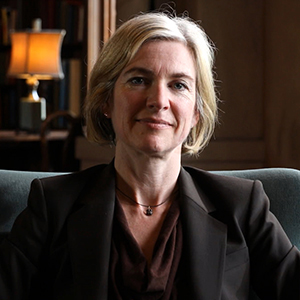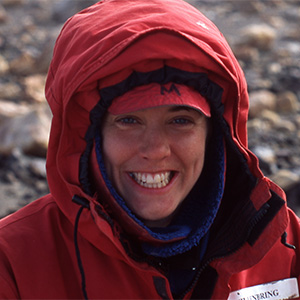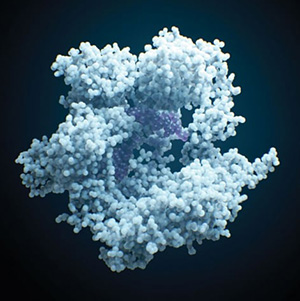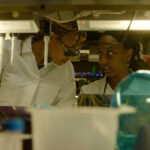Dipti Nayak, Ph.D.: I think archaea represent to some extent a blind spot in our understanding of natural diversity. You hear a lot of people talk, in many different contexts, about diversity, and they’ll bring up viruses, they’ll bring up eukaryotic cells, and they’ll bring up bacteria. But the archaea are often never even mentioned. What I want people to acknowledge when they hear about archaea is that this is a completely distinct domain of life that we should recognize for what it is, rather than blend it in with some other domain.
Understanding the tree of life, trying to figure out what the evolutionary relationships of all life forms on our planet… you know, it’s a point of curiosity. We all want to know where we came from. For the longest time, we’ve kind of had this belief in biology that there’s these two different and extremely distinct forms of life on our planet. One is everything that we can see, you know, right? From the insects, to the trees, human beings, other mammals, fishes, and so on and so forth… you know, the eukaryotes. And then there’s everything that’s invisible, and they were called the microorganisms or prokaryotes.
So, “prokaryote” was this all-encompassing term that was used for unicellular microorganisms that did not have organelles within the cells. So, their chromosome essentially just floats around in their cytosol. In contrast, the eukaryotes are organisms that have kind of evolved these complex organelles, one of which is the nucleus, which encapsulates all of their chromosomal material. And so, that distinction was what was used to kind of make evolutionary relationships between everything that does have a nucleus and everything that doesn’t. It turns out that it’s not as simple as that anymore.
In 1977, Carl Woese at the University of Illinois wanted to use not just how organisms look — their morphology — as a way to understand how they relate to each other, but looking at parts of their genetic material, their DNA, to make these evolutionary connections. The evolution of new species begin with mutations in DNA. These mutations can change genes, which in turn can change the physical traits of organisms. Sometimes, when an organism passes these genetic changes to their offspring, it can cause a new species to emerge.
In the 1960s, scientists began to wonder if they could determine the evolutionary relationship between different species by comparing their DNA sequences. The more similar the DNA sequences of two organisms, the more closely related they must be. Less shared DNA suggests a more distant relationship. To build a tree of life using this approach, Carl Woese needed to find a gene that he could compare across all life forms.

He chose one that is needed for cells to perform one of their most essential functions: making proteins. By comparing the sequence of this gene between different types of organisms, he was able to infer the tree of life. This particular molecule that he narrowed in on is called the 16S ribosomal RNA. By looking at just this one particular molecule he was able to glean kind of the evolutionary relationships of these organisms without even having to look at them.
So, the story goes that Woese was looking for microbial samples to do 16S ribosomal RNA sequencing for. He went up to one of his colleagues and asked him for these weird methane-producing microorganisms that his lab was studying. This colleague was Ralph Wolfe, who pioneered the study of these methane-producing microbes. And Ralph then handed him a vial of these methane producers and said, yeah, take these bacteria if you want to look at their 16S ribosomal RNA.
And when Carl Woese and his students took a look at those samples, they found that they were nothing like any of the others that they’d looked at, to the point that I think they had to repeat the study at least two or three times to validate the fact that the 16S ribosomal RNA was in fact that different. And so, when you look at them under a microscope, they might look similar. But if you look deeper into the cell, into the DNA, you see that they’re actually a very different group of organisms.
So, he knew that… he knew that he was on to something really, really big. The microbes that we all thought were just this one big pool of prokaryotes were not that. There were the bacteria that are very well established and studied. But then there were these archaea, this, you know, enigmatic third domain of life. Woese got so excited that as soon as he, like, made that first three-domain tree of life, he called up the New York Times, and it became the front page article the next day.
It was this interesting moment of serendipity. You know, the reason why we discovered archaea was this person, Carl Woese, who had this pioneering technology, but also the fact that, you know, his lab was situated next to that of someone who was studying an archaea. And then, it was those two things coming together that, you know, gave rise to this… this paradigm-shifting concept in biology.
So, archaea initially, when they were discovered, were found in extreme environments. So, one of the first archaea that was sequenced was isolated from a hydrothermal vent at the bottom of the ocean. Now, we’ve essentially found archaea everywhere in the environment around us, as well as within us. So, there’s archaea on our skin. There’s archaea in our oral cavity. We have archaea in our guts. And every other place that you can think of, there are archaea.
So, often, they’re around us, and we can even see them sometimes. We just don’t know them for who they are. For instance, if you are flying into the San Francisco airport, you’ll see these salt flats that have bright colors as you land. And that’s just a visual cue to you saying, here are archaea. You know, you don’t have to go too far to find them; they’re everywhere.
So, the methanogenic archaea that my lab studies… they produce 80% of the methane that’s being released to the atmosphere annually, which has a significant impact on climate change. They also have a very direct impact on human health sometimes, because these methanogens in our distal gut can be up to 10% of the microbial population, which is substantial. So, the amount of calories that you get from your food, and also how you digest your food… what kinds of components come from it… some of those factors also depend on these archaea in your gut.

These archaea are actually a lot like us. So, the way the cells replicate… or the way one cell becomes two cells, the way the cells make their proteins… a lot of those things are very similar to the way we do them, compared to the bacteria that are also unicellular. And that’s… and what that’s leading to is this theory, now, that, you know, the last common ancestor to all modern day eukaryotes came from an archaeon.
There’s kind of been a revolution in the field of archaea in the last five years. So, people went and found these samples in different marine sediments. And when they sequenced the organisms that lived there, they found this very evolutionarily distant group of archaea called the Asgard archaea. So, the Asgard essentially is a group. Within the Asgard, you have the Lokis and then a bunch of other archaea that are named after Norse gods.
These Asgard archaea… they have proteins in their cell that are called eukaryotic signature proteins or ESPs. And the reason why I’m highlighting this is because they’re typically proteins that are only associated with eukaryotes. These ESPs have not been found in other archaea or in bacteria. But now, we’re seeing the presence of these proteins in archaea as well.
So, these organisms… when you put them back on the tree of life to figure out where they are, they’ve essentially changed the topology or the way the tree looks now. Previously, there were three domains, and there was a shared ancestor between the archaea and all of modern day eukaryotes. There was a last common ancestor that we shared, and then the archaea split off and the eukaryotes split off. But now, what we’re seeing is that there is an archaeal ancestor that gave rise to the eukaryotes. What this seems to indicate is that these eukaryotes are branching from within the archaea and are closely related to these distant groups that we’ve recently found.
So, that essentially makes archaea even more closely related to us, now, than we’d initially believed. And that’s kind of changing that view of the three-domain tree of life back to maybe a two-domain tree of life — but the two domains are different. The two domains are both actually unicellular organisms, and the eukaryotes are branching from one group of these unicellular organisms.
So, now that you’re thinking about the tree of life slightly differently, one question that arises as a result is, how did that unicellular archaeal ancestor give rise to this complex eukaryotic cell? Now, one key evolutionary step that happened along the way to becoming a eukaryote was the fact that these cells had to acquire the mitochondrion.
What one hypothesis out there is is that an archaeal cell engulfed a bacterial cell, a free-living bacterial cell, and eventually that particular bacterial cell living inside the archaeon went on to become the mitochondria as we know it today. So, these Loki archaea encode these eukaryotic signature proteins. And when we look a little closer into what these… what these proteins do, they also provide us a hint as to how the complex eukaryotic cell may have arisen.
A lot of these proteins encode for interesting cytoskeletal features, the features that make up the body of the cell. They produce these appendages outside the cell, and these appendages look like they could be used to engulf another organism that would eventually become the mitochondria for the eukaryotic cell. There are also proteins that confer the cell the ability to engulf other cells through endocytosis. All of these proteins have functions that we can use to kind of make sense of how that engulfment of a mitochondria may have occurred. It almost seems like these Asgard archaea are primed for some of the functions that we ascribe to have happened for the first eukaryotic cell to have arisen.
It’s an interesting time to be an archaeal biologist because we’re kind of in this… this… you know, major transition in thinking about archaea from an evolutionary standpoint. Right now, we’re in this phase that we’re gathering a lot of information, and that information is kind of letting us build new hypotheses about the tree of life. As more information is revealed to us, we’ll kind of keep refining the tree of life.
It is extremely likely that in the future we’ll find something else, and that might make us want to revisit the tree of life again. They’re such an understudied group of organisms that I don’t think there’s one right question to ask. I think there’s so many things that we can look at. We know what’s unique about eukaryotes, and similarly with the bacteria. But very little is known about what it means to be an archaea. What is kind of unique and distinctive about them? We have a few things that we know, but we don’t really know their deep, dark secrets, so to say. It’s a good time to go learn more about that.
Nayak, D. D., & Metcalf, W. W. (2017). Cas9-mediated genome editing in the methanogenic archaeon Methanosarcina acetivorans. Proceedings of the National Academy of Sciences, 114(11), 2976-2981.
Nayak, D. D., Mahanta, N., Mitchell, D. A., & Metcalf, W. W. (2017). Post-translational thioamidation of methyl-coenzyme M reductase, a key enzyme in methanogenic and methanotrophic Archaea. Elife, 6, e29218.
Woese C and Fox GE. 1977. Phylogenetic structure of the prokaryotic domain: The primary kingdoms. Proceedings of the National Academy of Sciences 74(11): 5088-5090.
Woese C, Kandler O, & Wheelis M. 1990. Towards a natural system of organisms: Proposal for the domains Archaea, Bacteria, and Eucarya. Proceedings of the National Academy of Sciences 87: 4576-4579.
Sarah Goodwin (Wonder Collaborative): Executive Producer
Elliot Kirschner (Wonder Collaborative): Executive Producer
Shannon Behrman (iBiology): Executive Producer
Brittany Anderton (iBiology): Producer
Eric Kornblum (iBiology): Editor, Videographer
Derek Reich (ZooPrax Productions): Videographer
Adam Bolt (The Edit Center): Editor
Gb Kim (Explorer’s Guide to Biology): Illustrations
Chris George: Design and Graphics
Maggie Hubbard: Design and Graphics













